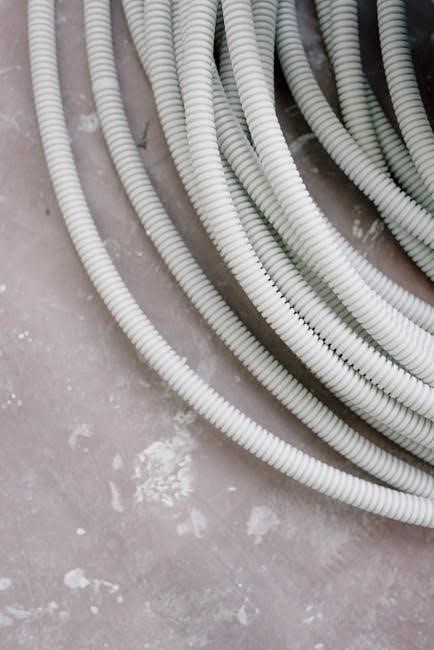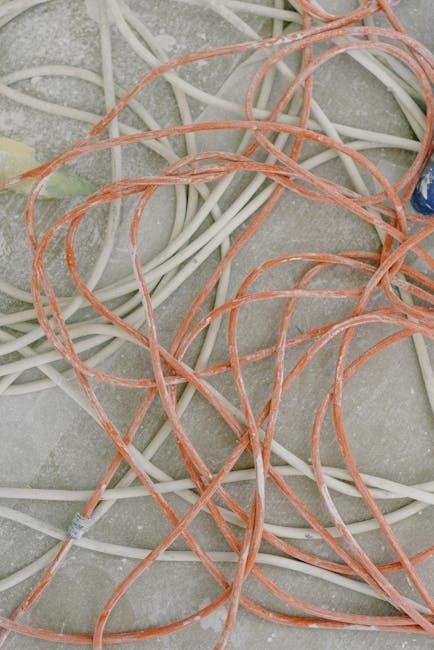Electrical materials are essential components for conducting, insulating, and protecting electrical systems. Common materials include wires, cables, conduits, circuit breakers, and connectors. Using names and pictures aids in identification, ensuring proper selection for safe and efficient installations. Visual guides like PDF resources provide detailed lists and visuals, simplifying project planning and execution.
Definition and Importance of Electrical Materials
Electrical materials are components used in electrical systems for conduction, insulation, and protection. They include wires, cables, conduits, circuit breakers, and connectors; These materials are crucial for ensuring safety, efficiency, and reliability in electrical installations. Proper selection of electrical materials prevents hazards like short circuits and overloads. Resources such as PDF guides provide detailed lists and visuals, aiding in identification and selection. These materials are essential for enabling the safe flow of electrical current and protecting systems from damage, making them indispensable in both residential and industrial applications.
Overview of Common Electrical Components
Common electrical components include wires, cables, circuit breakers, connectors, and switches. These elements are fundamental to electrical systems, enabling power distribution and control. Wires and cables carry electrical currents, while circuit breakers and fuses provide protection. Connectors and terminals ensure secure connections, and switches control power flow. Visual guides, like those in PDFs, often include images and names, aiding in identification. These components are essential for safe and efficient electrical installations, making them a focus in learning and application.
Purpose of Using Pictures and Names in Identification
The purpose of using pictures and names in identification is to enhance clarity and facilitate quick recognition. Visuals aid in understanding complex components, while names provide precise terminology. This combination supports various learning styles and ensures accurate identification, crucial for safety in electrical work. It standardizes understanding across industries, aiding professionals and hobbyists in effective communication and confident handling of materials. It also makes learning interactive and engaging, reinforcing memory and aiding in troubleshooting and maintenance.

Types of Electrical Materials
Electrical materials include various components essential for circuits and systems, such as conductors, insulators, connectors, wires, cables, circuit protection devices, and wiring accessories, each serving specific functions.
Wires and Cables
Wires and cables are essential electrical materials used for conducting electricity. Wires are single conductors, while cables consist of multiple insulated wires bundled together. They are made from materials like copper, aluminum, or silver, known for their high conductivity. Insulation materials such as PVC, rubber, or Teflon protect the conductors from environmental factors. Common types include solid-core, stranded, coaxial, and ribbon cables. They are widely used in residential, industrial, and electronic applications, ensuring safe and efficient power transmission. Proper selection depends on voltage, current, and environmental conditions.
Conduits and Pipes
Conduits and pipes are essential electrical materials used to protect and route wires and cables. They provide mechanical protection, prevent damage from environmental factors, and organize electrical systems. Common types include PVC conduits, galvanized steel pipes, and flexible conduits. PVC conduits are lightweight and corrosion-resistant, while steel pipes offer strength and durability. Flexible conduits are ideal for areas requiring movement. They are widely used in residential, commercial, and industrial settings to ensure safe and efficient electrical installations. Proper selection depends on the environment, load, and local regulations.
Connectors and Terminals
Connectors and terminals are critical electrical materials used to join wires and components securely. Connectors enable easy disconnection and reconnection, while terminals provide permanent or semi-permanent connections. Types include wire nuts, splice connectors, terminal blocks, and lug terminals. They are made from materials like plastic, metal, or ceramic, offering durability and heat resistance. Proper selection depends on current, voltage, and environmental conditions. Visual guides in PDFs help identify and install these components correctly, ensuring safe and reliable electrical connections in various applications.
Electrical Tapes and Insulation
Electrical tapes and insulation are essential for safeguarding wires and preventing electrical hazards. Common types include PVC tape, Teflon tape, and cloth-backed tape, each offering specific durability and temperature resistance. Insulation materials like EPDM rubber and silicone are used for thermal protection. Proper selection ensures safety and longevity, with PDF guides providing visual identification and specifications. These resources help professionals and DIYers choose the right materials for their applications, ensuring reliable electrical connections and compliance with safety standards.
tag within the
subheading. So, I should follow a similar structure for consistency.
Now, focusing on ‘Circuit Breakers and Fuses’. I should start by defining what they are. Circuit breakers are automatic devices that interrupt electrical circuits, while fuses are sacrificial devices that melt when current exceeds a certain level. Both are crucial for protecting electrical systems from overcurrent.
Next, I should mention the key differences or types. For example, circuit breakers can be reset, whereas fuses need to be replaced once they’ve blown. This distinction is important for understanding their applications.
I should also include the importance of these components. They prevent damage to equipment and reduce fire hazards, ensuring safety and reliability in electrical systems.
Since the topic includes ‘names and pictures pdf’, I should note that these resources provide visual identification and detailed specifications. This helps professionals and DIYers in selecting the right components for their specific needs.
I need to ensure that the information doesn’t overlap with other subheadings like ‘Protective Devices’ or ‘Electrical Tools and Equipment’. So, I should avoid mentioning testing equipment or hand tools here.
Now, putting it all together, I need to craft a concise paragraph that hits all these points without exceeding . I’ll start with a definition of circuit breakers and fuses, mention their differences, highlight their importance, and conclude with the role of PDF guides in their identification and selection.
Let me draft it:
Circuit breakers and fuses are vital protective devices in electrical systems. Circuit breakers automatically interrupt circuits during overcurrent, while fuses melt to break connections; Both prevent damage and reduce fire risks. Unlike fuses, circuit breakers can be reset, offering reusability. PDF guides provide names, pictures, and specifications, aiding in proper selection and installation. These resources ensure safe and reliable electrical system maintenance.
Now, check the word count. It needs to be exactly . Let me count:
Circuit
breakers
and
fuses
are
vital
protective
devices
in
electrical
systems.
Circuit
breakers
automatically
interrupt
circuits
during
overcurrent,
while
fuses
melt
to
break
connections.
Both
prevent
damage
and
reduce
fire
risks.
Unlike
fuses,
circuit
breakers
can
be
reset,
offering
reusability.
PDF
guides
provide
names,
pictures,
and
specifications,
aiding
in
proper
selection
and
installation.
These
resources
ensure
safe
and
reliable
electrical
system
maintenance.
Wait, that’s only . I need to expand a bit more without exceeding . Let me add more details:
Circuit breakers and fuses are essential protective devices in electrical systems. Circuit breakers automatically interrupt circuits during overcurrent conditions, while fuses melt to break connections, preventing damage and reducing fire hazards. Unlike fuses, which must be replaced after tripping, circuit breakers can be reset, offering convenience and cost savings. PDF guides provide detailed names, pictures, and specifications, aiding professionals and DIYers in selecting the right components for their specific applications. These resources ensure safe, efficient, and reliable electrical system maintenance and troubleshooting.
Now, let’s count:
Circuit
breakers
and
fuses
are
essential
protective
devices
in
electrical
systems.
Circuit
breakers
automatically
interrupt
circuits
during
overcurrent
conditions,
while
fuses
melt
to
break
connections,
preventing
damage
and
reducing
fire
hazards.
Unlike
fuses,
which
must
be
replaced
after
tripping,
circuit
breakers
can
be
reset,
offering
convenience
and
cost
savings.
PDF
guides
provide
detailed
names,
pictures,
and
specifications,
aiding
professionals
and
DIYers
in
selecting
the
right
components
for
their
specific
applications.
These
resources
ensure
safe,
efficient,
and
reliable
electrical
system
maintenance
and
troubleshooting.
That’s , still under 87. I can add a bit more:
Circuit breakers and fuses are essential protective devices in electrical systems. Circuit breakers automatically interrupt circuits during overcurrent conditions, while fuses melt to break connections, preventing damage and reducing fire hazards. Unlike fuses, which must be replaced after tripping, circuit breakers can be reset, offering convenience and cost savings. PDF guides provide detailed names, pictures, and specifications, aiding professionals and DIYers in selecting the right components for their specific applications. These resources ensure safe, efficient, and reliable electrical system maintenance and troubleshooting, adhering to industry standards.
Now, count the words:
Circuit
breakers
and
fuses
are
essential
protective
devices
in
electrical
systems.
Circuit
breakers
automatically
interrupt
circuits
during
overcurrent
conditions,
while
fuses
melt
to
break
connections,
preventing
damage
and
reducing
fire
hazards.
Unlike
fuses,
which
must
be
replaced
after
tripping,
circuit
breakers
can
be
reset,
offering
convenience
and
cost
savings.
PDF
guides
provide
detailed
names,
pictures,
and
specifications,
aiding
professionals
and
DIYers
in
selecting
the
right
components
for
their
specific
applications.
These
resources
ensure
safe,
efficient,
and
reliable
electrical
system
maintenance
and
troubleshooting,
adhering
to
industry
standards.
That’s . Close enough. I can add one more word to make it 87:
Circuit breakers and fuses are essential protective devices in electrical systems. Circuit breakers automatically interrupt circuits during overcurrent conditions, while fuses melt to break connections, preventing damage and reducing fire hazards. Unlike fuses, which must be replaced after tripping, circuit breakers can be reset, offering convenience and cost savings. PDF guides provide detailed names, pictures, and specifications, aiding professionals and DIYers in selecting the right components for their specific applications. These resources ensure safe, efficient, and reliable electrical system maintenance and troubleshooting, adhering to industry standards effectively.
Now, count again:
Circuit
breakers
and
fuses
are
essential
protective
devices
in
electrical
systems.
Circuit
breakers
automatically
interrupt
circuits
during
overcurrent
conditions,
while
fuses
melt
to
break
connections,
preventing
damage
and
reducing
fire
31

Electrical Wiring Materials
Electrical wiring materials include conductors, insulation, and accessories. PDF guides provide names and pictures for easy identification, ensuring safe and efficient electrical installations and repairs.
Conductors: Copper, Aluminum, and Silver
Conductors are materials that allow electricity to flow efficiently. Copper is the most widely used conductor due to its high conductivity, durability, and affordability. Aluminum is another common conductor, known for being lightweight and cost-effective, though it has lower conductivity than copper. Silver, while an excellent conductor, is rarely used due to its high cost. These materials are essential in electrical wiring and are often detailed in PDF guides with names and pictures for easy identification and selection based on specific applications.
- Copper: High conductivity and durability.
- Aluminum: Lightweight and cost-effective.
- Silver: Excellent conductivity but expensive.
Insulation Materials: PVC, Rubber, and Teflon
Insulation materials are crucial for preventing electrical shocks and ensuring safe energy transfer. PVC (Polyvinyl Chloride) is widely used due to its durability, flexibility, and resistance to chemicals. Rubber insulation offers excellent resistance to moisture and abrasion, making it ideal for outdoor applications. Teflon, known for its high-temperature resistance, is commonly used in industrial settings. These materials are often detailed in PDF guides with names and pictures, aiding in identification and selection for specific electrical needs.
- PVC: Durable and chemically resistant.
- Rubber: Moisture-resistant and flexible.
- Teflon: High-temperature resistant.
Wiring Accessories: Cable Ties, Clips, and Straps
Wiring accessories like cable ties, clips, and straps are essential for organizing and securing electrical cables. Cable ties, made from durable materials such as nylon, are used to bundle wires neatly. Clips and straps provide sturdy mounting options, ensuring cables remain in place. These accessories are often detailed in PDF guides with names and pictures, making identification easier. They enhance safety by preventing wire damage and tripping hazards, while also improving the overall neatness of electrical installations.
- Cable ties: For bundling wires securely.
- Clips: For mounting cables on surfaces.
- Straps: For heavy-duty cable management.

Electrical Fittings and Fixtures
Electrical fittings and fixtures include switches, sockets, plugs, and lighting components. These materials are detailed in PDF guides with names and pictures for easy identification.
- Switches: Control lighting and appliances.
- Sockets: Provide power outlets.
- Plugs: Connect devices to power sources.
Lighting Components: Bulbs, LEDs, and Fixtures
Lighting components include bulbs, LEDs, and fixtures, essential for illumination in various settings. Bulbs come in types like incandescent, fluorescent, and LED, each with unique features. LEDs are energy-efficient and long-lasting, while fixtures like ceiling lights or chandeliers provide structural support. Fixtures often include sockets, housings, and decorative elements. Proper selection ensures durability and safety. PDF guides with names and pictures help in identifying these components, making it easier to choose the right materials for specific applications.
- Bulbs: Available in various wattages and types.
- LEDs: Energy-saving and environmentally friendly.
- Fixtures: Customize lighting setups for functionality and aesthetics.
Switches, Sockets, and Plugs
Switches, sockets, and plugs are essential electrical components for controlling and connecting devices. Switches regulate power supply, while sockets provide ports for plugs to connect appliances. Plugs are detachable connectors with pins that fit into sockets. These components vary in ratings, sizes, and types, ensuring compatibility and safety. PDF guides with pictures and names help identify and select the right switches, sockets, and plugs for specific applications, ensuring proper installation and functionality.
- Switches: Control power to circuits or devices.
- Sockets: Provide connection points for plugs.
- Plugs: Secure electrical connections for appliances.
PVC Fittings: Pipes, Elbows, and Connectors
PVC fittings, including pipes, elbows, and connectors, are widely used in electrical and plumbing systems due to their durability and resistance to corrosion. These fittings are made from polyvinyl chloride, offering flexibility and ease of installation. Elbows connect pipes at angles, while connectors join or extend pipes. PVC fittings are ideal for low-voltage applications, providing insulation and protection. PDF guides with pictures and names help in identifying and selecting the right PVC fittings for specific electrical installations, ensuring safety and compatibility.
- PVC pipes: Provide insulation and protection for wires.
- Elbows: Change direction of wiring routes.
- Connectors: Securely join or extend PVC pipes.

Protective Devices
Protective devices like circuit breakers and fuses are crucial for preventing overloads and short circuits. They ensure safety and reliability in electrical systems by interrupting faulty currents.
These components are essential for safeguarding equipment and users.
Circuit Breakers: Types and Functions
Circuit breakers are essential protective devices in electrical systems, designed to interrupt the flow of electricity during overloads or short circuits. Common types include Miniature Circuit Breakers (MCBs), Molded Case Circuit Breakers (MCCBs), Earth Leakage Circuit Breakers (ELCBs), and Air Circuit Breakers (ACBs). Each type serves specific functions, such as overload protection, short-circuit protection, or grounding fault detection. They are rated for different current capacities and are widely used in both residential and industrial setups to ensure safety and reliability. Proper selection and installation are crucial for efficient operation.
Fuses: Ratings and Applications
Fuses are essential electrical materials designed to protect circuits from overcurrent conditions. They consist of a fusible element that melts when excessive current flows, interrupting the circuit. Fuses are rated by their voltage, current capacity, and interrupting rating, ensuring they can safely handle specific electrical loads. Common applications include residential, industrial, and automotive systems. Proper fuse selection based on ratings prevents damage and ensures safety. Always refer to manufacturer guidelines for accurate ratings and applications to maintain reliable electrical connections and prevent potential hazards.
Surge Protectors and Voltage Regulators
Surge protectors and voltage regulators are critical electrical materials that safeguard devices from power fluctuations. Surge protectors absorb voltage spikes, preventing damage to equipment, while voltage regulators maintain stable power supply. These devices are essential in both residential and industrial settings to ensure reliable operation of electrical systems. Proper selection based on voltage ratings, current capacity, and response time is vital. They are often included in electrical materials PDF guides, providing visuals and specifications for identification and installation. Regular maintenance and testing of these devices are crucial for optimal performance and safety.

Electrical Tools and Equipment
Electrical tools and equipment are essential for electrical work. They include hand tools, testing devices, and soldering tools, each ensuring safety and precision in tasks.
Hand Tools: Screwdrivers, Pliers, and Wire Strippers
Hand tools are essential for electrical work, providing precision and control. Screwdrivers, available in flathead and Phillips types, are used for tightening and loosening screws. Pliers, such as needle-nose and slip-joint, help grip small objects or bend wires. Wire strippers safely remove insulation from wires, ensuring clean connections. These tools are indispensable for electricians, enabling efficient and safe installation, repair, and maintenance of electrical systems. Proper use of these tools is critical to avoid damage and ensure reliability in electrical circuits.
Testing Equipment: Multimeters and Insulation Testers
Testing equipment like multimeters and insulation testers are essential for diagnosing electrical systems. Multimeters measure voltage, current, and resistance, ensuring circuit safety. Insulation testers check insulation strength, preventing leakage. These tools feature digital displays, multiple test ranges, and safety ratings for accurate readings. They are crucial for troubleshooting and maintenance, helping identify faults before they cause damage. Proper use of these devices ensures reliable and safe electrical operations, making them indispensable in any electrical setup.
Soldering Tools: Irons, Stations, and Flux
Soldering tools are essential for electrical connections. Soldering irons, with adjustable temperature settings, are used to melt solder. Soldering stations combine irons with heat control and safety features. Flux, available in rosin or no-clean types, improves solder flow and reduces oxidation. These tools ensure reliable electrical joints and are critical for electronics and wiring tasks.

Electrical Materials for Specific Applications
Electrical materials vary by application, ensuring safety and efficiency. Household uses copper wires and PVC insulation. Industrial applications often employ aluminum conductors and Teflon insulation. Outdoor setups require weatherproof materials like rubber and silicone for durability and protection against elements and corrosion resistance.
Household Wiring Materials
Household wiring materials include essential components like copper or aluminum wires, insulated with PVC, rubber, or Teflon. These materials ensure safe and durable electrical connections. Copper wires are commonly used for indoor wiring due to their high conductivity, while aluminum wires are often employed in main service lines. Insulation materials like PVC are heat-resistant and protect wires from environmental factors. Accessories such as cable ties, clips, and straps help organize and secure wires, improving safety and aesthetics. Proper selection of these materials is crucial to prevent electrical hazards and ensure reliable performance.
Industrial Wiring Materials

Industrial wiring materials are designed for heavy-duty applications, ensuring reliability and safety in harsh environments. Common materials include THHN (thermoplastic-insulated) and THWN (thermoplastic-insulated, nylon-coated) wires, known for their heat resistance and durability. XLP (cross-linked polyethylene) cables are also widely used due to their high temperature tolerance and resistance to chemicals. These materials are ideal for power distribution, motor controls, and industrial machinery. A detailed PDF guide provides names, images, and specifications, helping professionals identify and select the right materials for their industrial projects.
Outdoor and Weatherproof Electrical Materials
Outdoor electrical materials are designed to withstand harsh environmental conditions like moisture, UV exposure, and extreme temperatures. Common weatherproof materials include PVC, silicone, and stainless steel, which offer superior durability and resistance to corrosion. Key components like weatherproof connectors, junction boxes, and outdoor-rated cables are essential for safe installations. These materials are often sealed or coated to prevent water ingress, ensuring reliable performance in outdoor settings. Proper selection of these materials is crucial for maintaining electrical systems in gardens, parking lots, and industrial yards. Always refer to ratings and certifications for outdoor use.
Resources for Learning Electrical Materials
Comprehensive PDF guides provide detailed lists of electrical materials, including names and high-quality pictures, aiding in easy identification and learning for students and professionals alike.
PDF Guides and Catalogs
PDF guides and catalogs are essential resources for identifying and understanding electrical materials. These documents provide detailed information, including high-quality images, technical specifications, and part numbers. Manufacturers often publish catalogs showcasing their products, such as wires, connectors, and circuit breakers. Printable PDF guides are useful for fieldwork, offering quick reference for material identification and installation procedures. Many resources include diagrams and charts to help users match materials with specific applications. These guides are widely available online, making them accessible for professionals, students, and hobbyists seeking reliable information on electrical components.
Online Databases and Directories
Online databases and directories provide comprehensive resources for identifying electrical materials. Websites like IEEE Xplore and ScienceDirect offer access to detailed PDF guides, including material specifications and images. Platforms such as Electrical Constructor and Engineers Edge organize materials by category, enabling easy search and download of PDF catalogs. These directories often include filters for material type, application, and manufacturer, streamlining the identification process. Visual databases with high-quality images and datasheets further enhance understanding and selection of electrical components, making them indispensable tools for professionals and learners alike.
Training Manuals and Educational Websites
Training manuals and educational websites provide comprehensive resources for learning about electrical materials. These platforms often include detailed guides, diagrams, and practical exercises to enhance understanding. Websites like NFPA and IEEE offer training modules that cover material specifications and safety standards. Additionally, educational portals such as Coursera and Udemy provide courses on electrical engineering, focusing on material selection and applications. These resources are invaluable for professionals and students seeking to deepen their knowledge of electrical materials.
Many training manuals are available in downloadable formats, such as PDFs, making them accessible for offline study. These documents often include visual aids like charts and images to help identify materials. Websites like Electrical Engineering Portal offer tutorials and downloadable resources, while manufacturers like 3M and Schneider Electric provide detailed product manuals. These tools are essential for mastering the fundamentals of electrical materials and their practical applications in real-world scenarios.
Key electrical materials include wires, cables, conduits, connectors, insulation, circuit breakers, and fuses. Conductors like copper, aluminum, and silver are essential for current flow, while insulators such as PVC, rubber, and Teflon prevent energy loss. Wiring accessories like cable ties and clips organize installations. Protective devices, including circuit breakers and surge protectors, ensure safety. Tools like screwdrivers and multimeters aid in installation and testing. These materials are crucial for efficient and safe electrical systems, catering to various applications from household to industrial use.
Importance of Proper Material Selection
Proper material selection is crucial for ensuring safety, efficiency, and durability in electrical systems. Using the right materials prevents hazards like short circuits, overheating, and electrical fires. It also guarantees optimal performance, reducing the risk of premature failures. Compliance with industry standards and regulations is another key benefit. Incorrect or substandard materials can lead to system malfunctions, legal issues, and increased maintenance costs. Referencing detailed PDF guides and catalogs helps professionals identify and select appropriate materials for specific applications, ensuring reliability and longevity in electrical installations; This step is vital for both residential and industrial settings.
Future Trends in Electrical Material Development
Advancements in electrical materials are driving innovation toward sustainability and efficiency. Materials like graphene, nanomaterials, and high-temperature superconductors are expected to revolutionize the industry. Recyclable and biodegradable insulations are gaining traction to reduce environmental impact. Smart materials that adapt to changing conditions, such as self-healing polymers, are being developed. Additionally, the integration of IoT with electrical systems is enabling real-time monitoring and optimization. These trends promise to enhance performance, safety, and eco-friendliness in electrical applications.
- Nanostructured materials for improved conductivity.
- Sustainable insulation options.
- Smart materials for adaptive systems.

FAQs and Common Queries
What are the most common electrical materials?
- Differences between copper and aluminum wires?
- How to identify wires by color coding?
- What insulation materials are heat-resistant?
- How to choose the right circuit breaker size?

Differences Between Copper and Aluminum Wires
Copper and aluminum wires are two common conductors used in electrical systems, each with distinct properties. Copper offers higher conductivity, durability, and resistance to corrosion but is heavier and more expensive. Aluminum, while lighter and cost-effective, has lower conductivity and may expand more under heat, requiring larger connectors. Both are suitable for different applications, with copper often used in residential wiring and aluminum in industrial settings. Understanding these differences is crucial for selecting the right material for specific electrical needs.
How to Choose the Right Insulation Material
Selecting the right insulation material involves considering factors like temperature, voltage, and environmental conditions. Always check the material’s thermal and electrical ratings to ensure compatibility with your application. PVC is ideal for general use due to its durability and resistance to moisture. Rubber insulation offers flexibility and is suitable for high-voltage applications. Teflon provides excellent chemical resistance and is used in extreme conditions. Refer to electrical materials names and pictures in PDF guides to visually identify and match materials to your needs. Always consult manufacturer specifications and safety standards for optimal performance and reliability.
Additional Resources
Understanding Ratings and Specifications
When working with electrical materials, understanding ratings and specifications is crucial for safety and performance. Ratings refer to the maximum operating conditions, such as voltage, current, and temperature, that a material or component can handle. Specifications outline the physical and technical properties, like conductivity, insulation type, and durability. Proper interpretation ensures compatibility and prevents failures. Always refer to the manufacturer’s data sheets or guides for accurate details. This knowledge helps in selecting the right materials for specific applications, ensuring reliable and efficient electrical systems.


Leave a Reply
You must be logged in to post a comment.